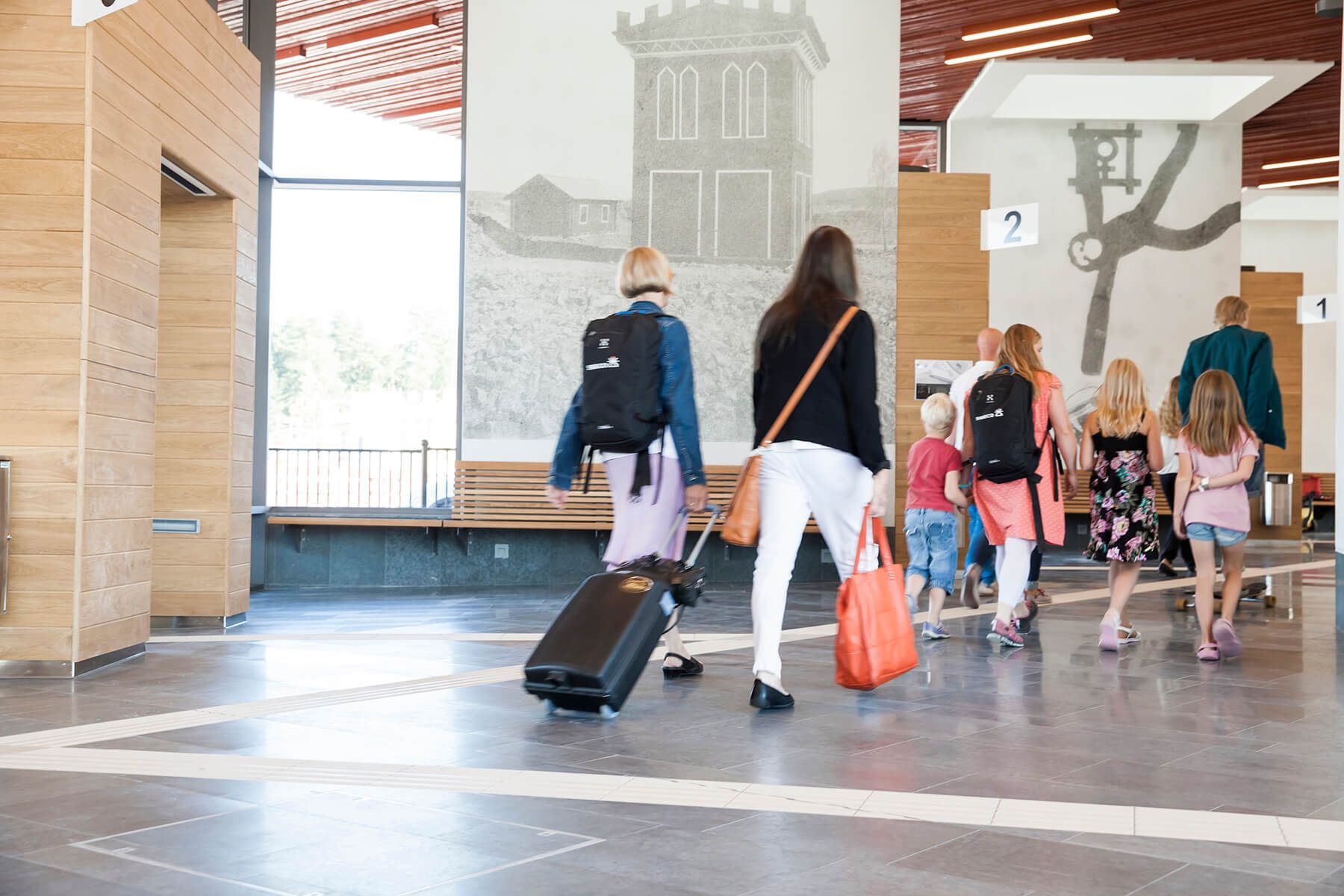Hub for past and future - Falun Travel Centre
BY GRAPHIC CONCRETE
11.12.2015

The Falun Travel Centre (Resecentrum Falun) is an important addition to the changes that have been made to the city’s southern centre and its public transportation hub. Sweco Architects have been involved in the project for over 10 years. The new terminal combines both train and bus services while also creating a connection between the city and regional transportation. The entrance to the terminal serves as a link between the old train station and the new bus station.
The bus terminal can handle ten buses at a time. It also houses a shop and staff facilities. An elongated arch connects the platforms, while the backbone consisting of a large grass roof and skylights creates an urban silhouette.Falun’s appeal as a world heritage site is reflected by the white graphic concrete slabs next to each platform, the red ochre roof beams and the copper wire mesh ceiling. The large open glass surfaces make each visit exciting and appealing, but also light and safe. The environment had to be designed to withstand a lot of wear. Accordingly, the materials chosen for this project included graphic concrete made of Aalborg’s white cement, light glass walls, limestone floors, and oak benches and steps.


“We wanted a light, durable surface for the inside walls, and we found that graphic concrete using Aalborg’s white concrete was the ideal choice for this purpose,” says Hans Pettersson from Sweco Architects. “Falun has a long tradition as a home of graphic artists, such as Axell Fridell, Einar Norelius and Stig Borglind. The same tradition continues this day with Modhir Ahmed, head of the local graphic arts workshop. It was fun combining modern image reproduction techniques with Falun’s graphic design history,” he continues.
http://www.falun.se/gora--uppleva/kultur/konstgrafisk-verkstad.html
“The municipality like our idea and formed a committee to decide which themes should be represented in the concrete patterns. The main theme that was chosen was Falun as a world heritage site,” Pettersson says.
http://worldheritagesweden.se/varldsarv-i-sverige/varldsarvet-falun/
Three of the patterns are Modhir Ahmed’s free graphic interpretations of Falun as a world heritage site, three represent photographs taken by photographer Olle Norling of Falun’s UNESCO World Heritage Site buildings, and three are taken directly from the international world heritage list.
“Graphic Concrete helped us screen the photographs. I am very satisfied with the result. I especially like how the surface texture appeals to the senses, providing a dimension that can be experienced by touching the wall,” Pettersson continues.
The municipality is also considering holding art exhibitions in the terminal, as it is the perfect place to reach large numbers of people.
“The biggest challenge in using graphic concrete is to reproduce the photographs as sharply as possible. We made three test castings with different shades of black and three different mixtures. We eventually chose the darkest mixture, which created the sharpest images,” Pettersson explains.
Project Details
Sweco committee
Falu Resecentrum, Dalatrafik bussterminal
Project supervisor: Mathias Ahlgren
Chief architect: Hans Pettersson
Partner architects: PeGe Hillinge, Rob Kirkham, Ylva af Kleen, Johan Udden
Landscape architect: Andreas HanssonChief engineer: Ola Staffansson
Construction engineer: Hans Persson,Transport planning: Claes Johansson Art committee
City architect, Per Grundström
Falun world heritage site coordinator, Christina Staberg
Artist, Modhir Ahmed
Cultural manager, Ivan Feldborg
Sweco Architects Falun, Hans Pettersson
Art by the bus platforms
Platform 2: Pigment, Artist: Modhir Ahmed
Platform 3: Adolf Fredriks Lave, Falu Gruva. Detail of the Falun World Heritage Site. Photographer: Olle Norling
Platform 4: Hedens Bergsmansgård, Falun. Detail of the Falun World Heritage Site. Photographer: Olle Norling
Platform 5: Gruvarbetarbostad Bult Karl-Eriks stuga, Elsborg. Detail of the Falun World Heritage Site. Photographer Olle Norling
Platform 6: Mamma, Artist: Modhir Ahmed
Platform 7: Egyptian pyramids, World Heritage Site since 1979. Photographer: Modhir Ahmed
Platform 8: Great Wall of China, World Heritage Site since 1987. Photographer: Per Grundström
Platform 9: Påskön, Chile, World Heritage Site since 1995. Photographer: Carlos Aranguiz
Platform 10: Dans och musik, Artist: Modhir Ahmed
Text source: Hans Pettersson / Sweco Architects